Roughly 4.6 billion years ago, Earth would gain its first atmosphere, yet this was an atmosphere that was completely unlike the atmosphere we know today. Today’s oxygen-rich atmosphere we’re familiar with didn’t form until the Proterozoic, between 2,500 and 541 million years ago, when oxygen-producing bacteria killed off much of the previously thriving life from the preceding Archean.
This, along with studies of massive insects such as the 75 cm wingspan Meganeuropsis permiana dragonflies from the Permian, and reconstructed temperature, oxygen, and carbon dioxide levels via paleoclimatology show periods during which Earth’s atmosphere and accompanying climate would be unrecognizable to us humans.
Human history covers only a minuscule fraction of Earth’s history during arguably one of the latter’s coolest, least eventful periods, and yet anthropogenic (man-made) climate change now threatens to rapidly change this. But wait, how do we know what the climate was like over such vast time scales? Let’s take a look into how we managed to reconstruct the Earth’s ancient climate, and what these findings mean for our prospects as a species today.
Welcome to the Holocene
The current geological era is called the Cenozoic (also known as the Age of Mammals), which encompasses 66 million years, divided into three periods:
- Paleogene: 66 – 23.03 million years ago (Mya)
- Neogene: 23.03 – 2.58 Mya
- Quaternary: 2.58 Mya – today
The Quaternary forms roughly the period in which recognizable humans existed and consists of two epochs:
- Pleistocene (2.58 Mya – 11,700 ya)
- Holocene (11,700 – today)
Some have proposed we recognize a new geological epoch called the Anthropocene (‘human epoch’), which would be defined as the epoch in which human activity first began to leave significant traces in the geological record. Although still the subject of intense debate, the search is on to find a so-called ‘golden spike’ in the geological record that may consist out of radionucleotides, heavy metals, fly ash and similar finds which would be indicative of the rise of human activity during the early 20th century.
If the Anthropocene becomes the new current epoch, its beginning would likely be placed around the 1950s. Yet the Holocene and to some extent the Pleistocene are probably our best indicators for what counts as the current ‘normal’, as far as Earth’s current climate and global temperatures goes, and what would be the result of so-called ‘forcings’. These are influences that force the global temperature to be higher or lower than it would otherwise have been, ranging from volcanic eruptions, meteor impacts, and solar activity, to human activities.
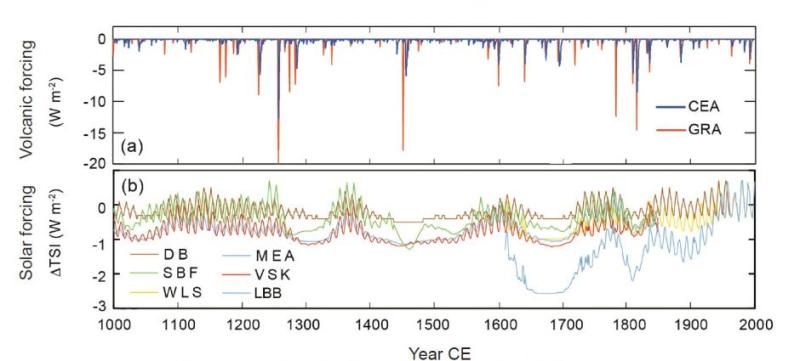
As explained by the National Centers for Environmental Information (formerly NCDC) at the National Oceanic and Atmospheric Administration (NOAA), the pattern of forcings for the past 1,000 years is quite clear. When comparing the influence of solar activity (through radioactive 14C and 10Be isotopes in ice cores and tree rings) as well as that from volcanic eruptions (via sulfate (SO42-) layers) there is a strong correlation within simulations, up until the 20th century.
This is even more clear when one looks at the followed comparison of global temperatures based on nearly a dozen published studies:
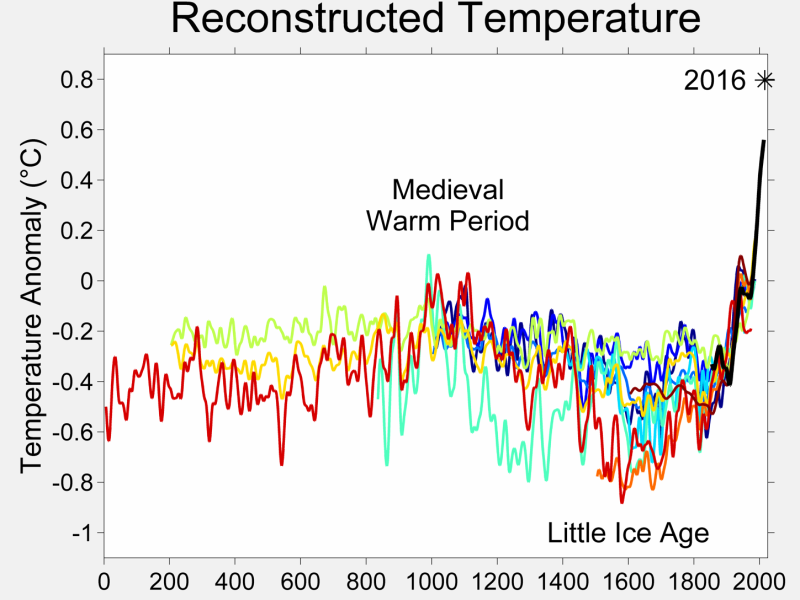
Climate by Proxy
While the preceding graphs make it both rather obvious that the global temperature rise observed during the 20th and current 21st century are not being forced by increased solar activity or similar positive influence, it is pertinent to put this dramatic rise in context using Earth’s geologic temperature record for the past 500 million years:

Much like for the past thousand years, these temperatures were reconstructed through climate proxies: geological and other markers which have in some way recorded characteristics from which meteorological measurements (e.g. temperature) can be deduced. Each of these proxies have a limit to how far back in time they can take us, either through the gradual (radioactive) decay of the marker, or because of how much of the proxy exists (e.g. thickness and age of an ice sheet).
Of these proxies, ice cores are probably the most well-known. These can take us back to approximately 800,000 years and provide us with air samples from a specific period from trapped air bubbles. In addition, impurities such as sand and ash can provide clues to atmospheric events — our own Jenny List wrote an article about how lead from human smelting activities in the 13th century was found in alpine glaciers. This allows us to construct graphs such as the following using Vostok Station ice cores:
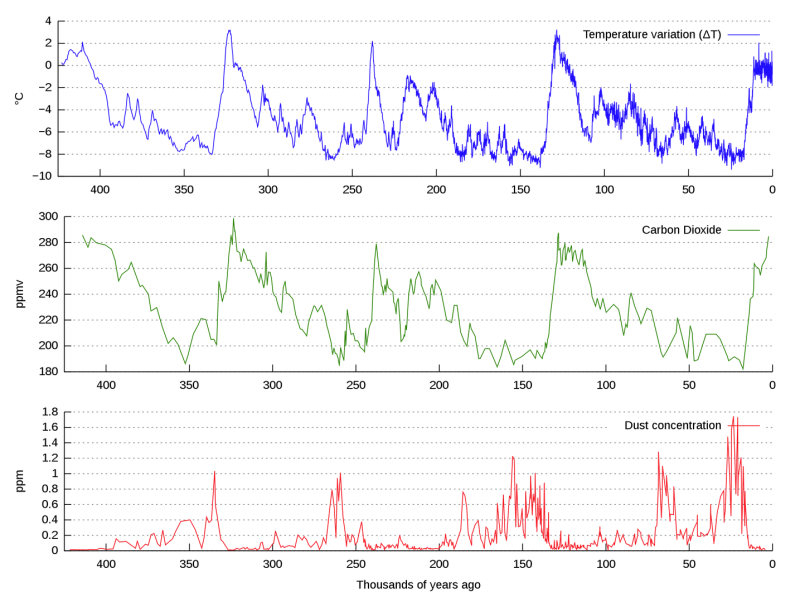
This graph covers the past 420,000 years, with CO2 levels staying well below 300 ppm (parts per million). Atmospheric CO2 measurements today (as of June 2021) are well over 410 ppm. In the absence of other forcing events, this might conceivably explain the rapid global temperature rise. CO2 levels along with similar gases such as methane (CH4) are an obvious cause through radiative forcing. This effect is commonly referred to as the ‘greenhouse effect’.
While the Earth’s atmosphere serves to retain warmth in this fashion to maintain the biosphere and the fragile life in it, by changing the magnitude of the radiative forcing, this can result in dramatic increases or drops in global temperatures. This saw for example the Cambrian (541 Mya – 485.4 Mya) with atmospheric CO2 levels of about 4,500 ppm and a global temperature of 7 °C higher than the pre-industrial temperatures of the 19th century.
Another such maximum was the Paleocene-Eocene Thermal Maximum (PETM) which saw a significant global temperature increase of 5–8 °C around 55.5 Mya. This was linked to volcanism and significant changes in Earth’s carbon cycle. As a result of these changes there were mass-extinctions of many species.
Clearly, the Earth’s climate has been much warmer and featured much more atmospheric CO2 than today, so exactly what is the matter with today’s changes, and the target of staying below a global temperature increase of 3°C? The answer here can be summarized succinctly by pointing at these mass-extinctions found in the geological record and the realization that humans have evolved only over the past 300,000 years, give or take a millennium.
Habitat Destruction
One of the hallmarks of evolution is that a species evolves to fit a certain environment. As the Earth’s climate changes between extremes, certain species will find that they are poorly equipped to handle these changes. This can involve a drop or rise in temperatures, changing oxygen levels (what likely drove Meganeura dragonflies to extinction) and the destruction of the habitat through events like desertification.
While one may scoff at rising temperatures, and consider the amazing technologies we have such as air conditioning, it bears to keep in mind that a body temperature of 40°C (104°F) is considered a medical emergency, and human thermoregulation may already fail when exposed to a wet-bulb temperature of 35°C (95°F) over 6 hours, resulting in a fatal case of hyperthermia.
Steven C. Sherwood et al. found that due to heat stress, many parts of Earth’s surface may become uninhabitable and even lethal to humans due to this heat stress. Along with humans, other animals would also be exposed to these temperatures, as well as all plant life. While we can put ourselves in air conditioned rooms and vehicles, we cannot do the same with livestock, crops and entire ecosystems. Eventually, after only a few hundred years, this could cause the worst extinction event since the PETM.
End of the Anthropocene
One might wonder what could be the golden spike that would indicate the end of the Anthropocene (that hotly debated ‘human epoch’ mentioned earlier) and the beginning of a new epoch. The pessimistic view there is that humanity may not be around to witness this change, and thus that it may not matter. For the optimistic view there is the notion that it could be the point where humanity found a way to avoid creating forcings that will ultimately end up destroying the habitat and climate on which it relies to survive.
Here the reduction of pollution and especially the release of gases such as CO2 and CH4 into the atmosphere is generally considered the most effective way to prevent a worst-case scenario as described by Steven C. Sherwood et al. Yet this approach is also proving to be exceedingly difficult, as evidenced by humanity’s continued use of fossil fuels, considered to be the primary source of these carbon-based gases: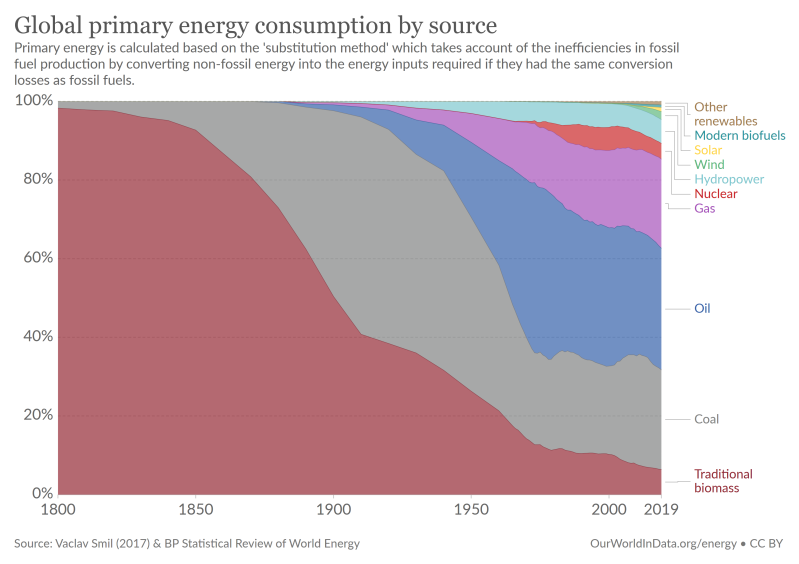
Clearly the overwhelming majority of the energy that powers human societies today comes from fossil fuel sources, after these took over from traditional biomass (i.e. burning wood and similar). Each of these sources come with its own ‘carbon budget’, as we can see when we look at the lifetime carbon emissions for these sources when used in electricity production:
If we wish to rapidly reduce the amount of CO2 and CH4 in the atmosphere, we should be using more of the sources on the right-hand side, and none of the sources on the left. As much as we as a species are loathe to admit it, at this point in time, located on the very edge of the geologic climate record, humanity is the primary forcing factor in Earth’s climate.
While changing the climate is a pretty unique property not seen since Proterozoic bacteria wiped out much of Earth’s life through the production of toxic oxygen, it also comes with a certain amount of responsibility. Here we have an excellent opportunity to prove the notion that humans are in fact the pinnacle of intelligent life.

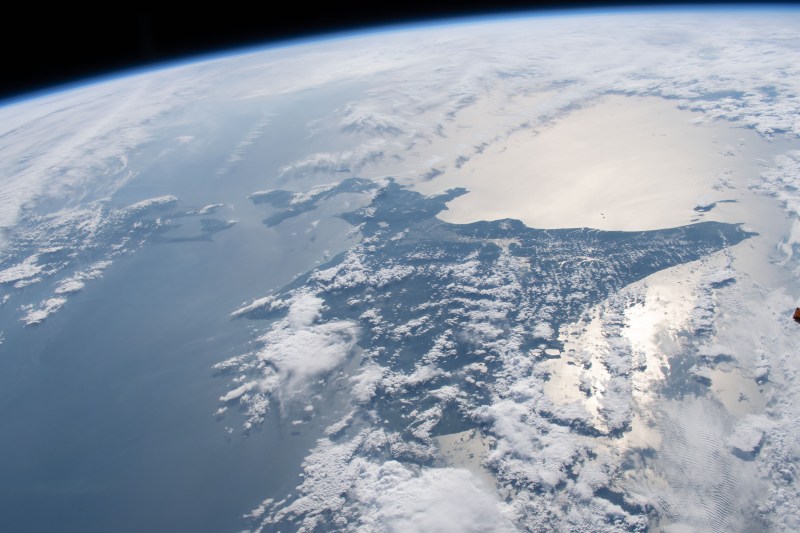
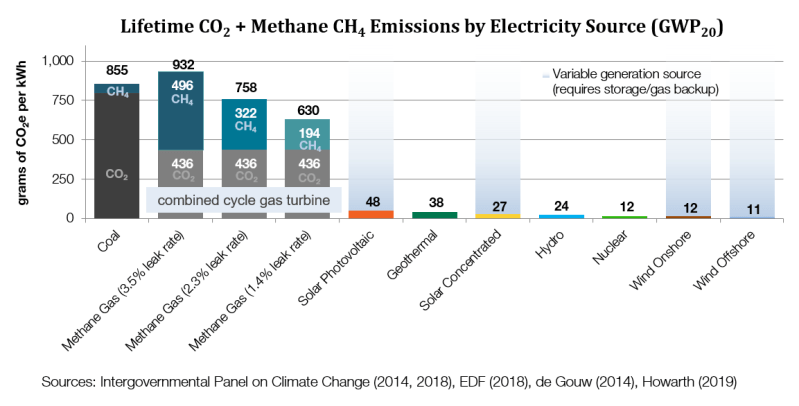














The anthropocene probably begins far earlier. Around the beginning of agriculture when land clearance (CO2) and rice farming (CH4) became significant. See the work of Ruddiman.
Indigenous Australians have been practicing large scale burning and hunting for at least 50,000 years which most probably contributed to the extinction of that continent’s megafauna around 40,000 years ago. i.e. The process is that old and took only 10,000 years to radically transform the ecosystems of Earth’s largest island.
Climate change has been politicized to the point where most clear-thinking people ignore the subject. Am I concerned about climate change and what may be causing it? Yes, of-course. But I cannot determine who is telling the truth and who is lying anymore.
Science isn’t political, just listen to the scientists. We know what’s causing climate change and we know how to slow it down.
This seems like it’s already decayed to the “how can we ever know anything!?” cult classic stage of the conversation.
I’m still working on preventing the ice age predicted by scientists when I was in middle school. They are not fooling me now.
Bsed on your username, perhaps this was a joke. Just in case it isn’t, there’s a difference between warming in your lifetime, and cooling in the next 100 000 years.
Do not confuse scientists telling the public we must stop polluting with someone trying to “control your life”.
The early Eocene was +14C hotter than today and the mid-late Plasticine was -10C cooler? Frankly, now I am completely unconcerned about a couple degrees of global warming in the next hundred years.
Yeah, life looks like it can survive in a pretty large range of situations (although not all – if Venus and Mars turn out to have harbored it at some point). The issue is whether humans can. Or why we’d want to. Why not keep the ecosystem we evolved in? I for one prefer it!
Following that logic all humanity would be living in sub Saharan Africa, humans have been living in “unnatural” environments for hundreds of thousands of years, 2C is no big deal.
Well, we’re talking about climates our species has never seen before, so that’s just a dishonest argument. And who has the ability to pack up and move to a comfortable spot? Not everyone. Certainly not non-humans. Which leads to shortages, border crises and general unpleasantness. How about, instead of the Thunderdome future, we just grow up and live within our means, atmospherically? Why all the resistance?
Try and concentrate.
I had this drilled into my head in metrology class: You must have a standard to measure by.
If they aren’t using the same measuring instruments, today, that they used to measure these metrics from 2 million years ago, then it is all made up and means absolutely nothing.
Good thing some end at 1970 CE, then.
PS: That’s a horrible, snottish way to open a comment.
that is something I have struggled with through out this debate on the issue – the noted rise in temperature also coincides with the development of tools to accurately measure temperature, CO2, methane etc..
There is particular period in Austrlalias recent history where temperatures recorded in the late 1700’s were our highest recorded temperatures but they are not considered because the measurements were not conducted in accordance with the current “standard” of temperature measurement. (The thermometer was hung in a tree) Yet historical temperature “evidence” is provided by chopping down the tree the thermometer was mounted in and reading the temperature from the growth rings or whatever method they use for estimating the temperature.
Not want to be ignorant soul I find the accuracy of data is some what lacking over a significant period of time to make a claim either way.
Here, there is not a single standard, but there are definitely overlapping standards, and these can be used to cross-calibrate each other. That should make sense given your metrology background.
yeah, but.. Suppose some measurable variable is well correlated with Earth temperature. Today we have fine instruments and can determine the relationship between this variable and modern accurate temp measurement. Then it is reasonable to use the relationship derived to estimate past temperature if the variable can be historically measured. Yes at some point correlation IS causation.
There seems to be a clear message that the planet is warming anyway and cycles through various temperature ranges and CO2 levels. The issue therefore would appear to be that the real problem is that the human race is accelerating that process and risking pushing it into a totally different phase. It also ignores the wholesale consumption of resources at a rate that far exceeds the natural processes that cycle those resources. All of which argues that the actual issue is one of uncontrolled over-population.
I’m interested in the 4500ppm CO2 levels 500M years ago and the temperature rise above current of 14C.
That would tend to imply that the CO2 level to warming effect ratio is distinctly non-linear.
Have there been any further studies of the linearity (or otherwise) of this relationship that anyone can point me to?
As it seems to me that once we get into the positive-feedback stage (may already be happening, but siberian permafrost is the next biggy) we could end up in the 1000ppm+ ballpark with no further fossil fuel inputs, and I’d like to know where the greenhouse effect starts “topping out” as it were.
It’s logarithmic. 285ppm to 570ppm has the same effect (+4C estimated) as 570ppm to 1140ppm. So, in theory 4500ppm is +16C overall (though I haven’t specified how long it takes for the heat imbalance to be corrected here).
Logarithmic / exponential tend to rouse my suspicions. Everything modeled with or fitted to first order differences equation has an exponential solution. This is the source of all the dire warnings of the second half of the 20th century. World starvation by 1980, peak oil by 1990, and all the predictions of the infamous “Limits to Growth”.
abjq: The IPCC report is worth a read. All the important studies are in there.
https://www.ipcc.ch/report/ar6/wg1/downloads/report/IPCC_AR6_WGI_Full_Report.pdf
My understanding is that there’s no real limit (or “topping out”). I’m not a scientist, so take it with a grain of salt, but one of the issues for us is that there are several big systems that transfer heat from the equator to the poles that are stable within a certain temperature range and likely to change course dramatically under different conditions. So those systems may settle at a different equilibrium under different atmospheric compositions, just not one that’s conducive to us. It’s not really about linearity or non-linearity.
The big ones I’ve been reading about are the Hadley circulation, which moves hot and humid air from the equator vertically and then transfers it poleward, and the Atlantic circulation, which moves warm water from the equator toward Greenland and Europe. Both of those circulations have changed dramatically at different periods, causing mass extinctions and changing the climate rapidly.
It’s not that the earth is in danger, it’s that the biological systems our species grew up with are likely to change a lot, which will make everything suck for humans unnecessarily (in my opinion). Places that used to be farmland will be desert, places that were stable will be hard to live in, ecosystems we rely on that take millennia to develop won’t be able to catch up, so we’ll lose plants and animals we rely on. And there’s already a huge migration under way from areas that are hard to survive in to areas that aren’t.
These arguments about the science are straw men. “Don’t sh_t where you eat” seems like a non-controversial adage.
Medieval Warm Period, Little Ice Age. Scoop of vanilla, scoop of chocolate, don’t waste my time.
Google Paleocene-Eocene Thermal Maximum.
Values are too high? Test less.
Yeah, right.
We should live cleaner because WE CAN.
What bothers me is how we may be manipulated to filling up someone’s pockets in the process. I truly think much of the regulation about lightbulbs was making sure that those in power had their money in the right place before we were forced into CFL and LED lamps. Same for the “green revolution”.
it is a force of will for humanity to generate clean power. We should really stop with all the technologies that are not energy dense and focus on things like Nuclear to generate clean power using Gen IV designs.
And when it comes to geo-engineering, why shouldn’t we try? To be able to mitigate the effects of higher atmospheric temperatures if for no other reason BECAUSE WE CAN.
Fixing drought? Don’t some areas flood? Can’t we move the flood waters to places where droughts are occurring? We’ve been moving water for millennia now!
But we argue, we postulate, we theorize and do exactly nothing.
The hottest summers were from the 1930s. Besides, even if CO2 nonsense were true, how would me paying $10 per gallon for fossil fuel and giving the money to a government agency improve the situation? Why should elite incompetent snobs like Obama and Kerry and other believers fly around in private jets and live in huge homes if the situation is so dire? Don’t these two have a modest ‘cottage’ on the allegedly rising sea levels of the Atlantic Ocean?
And what about all those burning coal seams across the world releasing CO2? And that fire hole(s) in Central Asia?
Really informative graphs, thank you Maya.